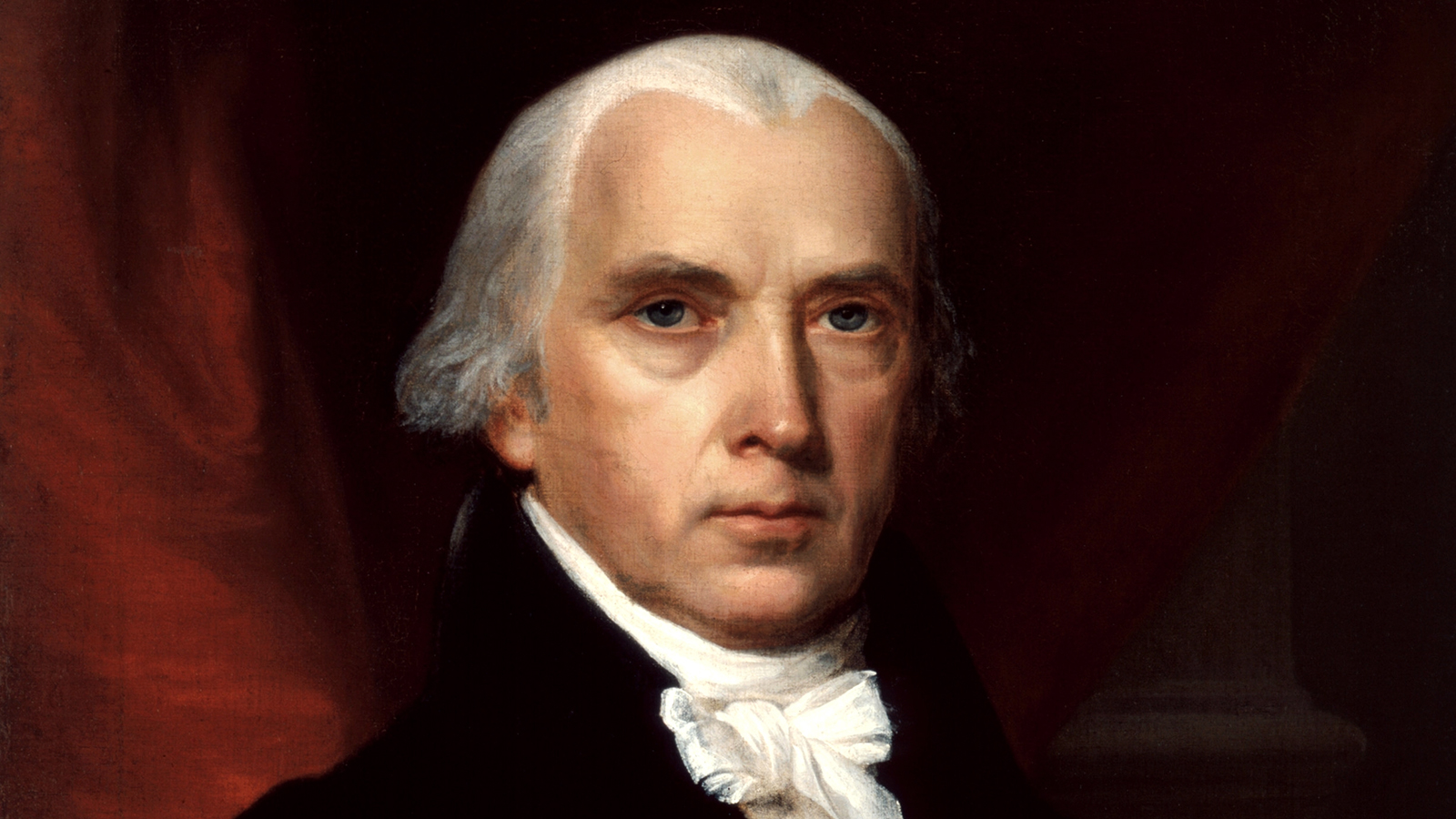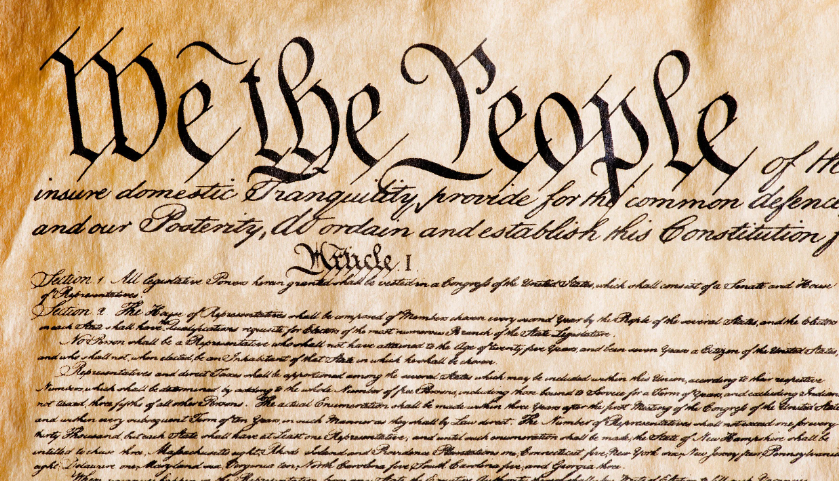Dalia Savy
J
James Glackin
AP US History 🇺🇸
454 resourcesSee Units
The Delegates
Who was responsible for creating the Constitution? Twelve states sent delegates, with Rhode Island being absent. Fifty-five white males were appointed by their state legislatures. All of these men owned property and came from a wealthier class.

James Madison was a central figure in the reconfiguration of the national government. Madison’s Virginia Plan was a guiding document in the formation of a new government under the Constitution. John Vanderlyn, Portrait of James Madison, 1816. Wikimedia.
Thomas Jefferson called these men “demigods.” Many of these highly respected men were lawyers and had experience in creating state constitutions. James Madison had spent years studying world history, Enlightenment texts, and political writings and used that information for a plan for the new Constitution. As a result, he is often given the title “Father of the Constitution”.
George Washington was elected as the chairman. James Madison, Ben Franklin, and Alexander Hamilton all played key roles. Notable absentees were Thomas Jefferson, Patrick Henry, Sam Adams, and Thomas Paine. None of these men came from the poorer masses.
After several debates at the Constitutional Convention, The Constitution was finished on September 17, 1787, and then sent to the states for ratification.
👉 Not sure how the Constitution came to be and the different plans for representation in Congress? Be sure to check out the last study guide about the Constitutional Convention before moving forward.
Ratification
In order for the United States Constitution to go into effect, nine of the thirteen states had to ratify it; this would prove to be difficult. Each state held special elections to choose representatives, known as ratifiers, who would be responsible for voting on whether or not to ratify the Constitution. The ratification process took place between 1787 and 1788.
The ratifiers were divided into two main groups: Federalists and Antifederalists.
- Federalists were in favor of ratifying the Constitution and believed that a stronger national government was necessary to address the problems facing the country under the Articles of Confederation. They argued that the Constitution would provide the needed stronger central government that would be better able to regulate commerce, provide for the common defense, and protect individual rights. They were often propertied men who did not believe in states' rights.
- Antifederalists, on the other hand, were opposed to ratifying the Constitution. They believed that the Constitution would create a powerful national government that would threaten the rights and sovereignty of the states. They also worried that the Constitution did not include a Bill of Rights to protect individual liberties and that it would lead to an oppressive government. Antifederalists were largely rural farmers.
For a visual explanation of the differences between the two:
| Federalist | Anti-Federalist | |
| Leaders | Alexander Hamilton, James Madison, John Jay | Patrick Henry, Samuel Adams, John Hancock |
| Stance | The Articles of Confederation is weak; favored stronger central government | Liked elements of the Articles; favored weak central government and stronger state governments |
| About Them | Mostly wealthy property owners | Mostly small farmers, shopkeepers, laborers |
| Supports | Federalist Papers | Strong national government threatened rights of the common people |
| Powers of central government need to be strengthened to protect the nation on a global scale and solve domestic problems | Constitution lacked Bill of Rights | |
| Strong national government over uncooperative states | Argued against 2/3 ratification | |
| Men of talent should rule; feared mobocracy | Opposed omitting God | |
| National government should protect rights | Created a strong executive similar to monarchy | |
| Checks and balances would protect against abuses |
The Federalist Papers
The Federalist Papers are a series of 85 essays written by Alexander Hamilton, James Madison, and John Jay to promote the ratification of the United States Constitution. They were published in various New York newspapers under the pseudonym "Publius" between October 1787 and August 1788. The essays explained the features of the proposed Constitution and sought to persuade the citizens of New York to ratify it.
The Bill of Rights
Some states ratified it quickly and unanimously, while others took longer and the ratification was passed by a close vote. Delaware was the first state to ratify it in December of 1787, and Pennsylvania soon followed.
Massachusetts ratified only after the promise of a Bill of Rights to ensure the preservation of individual liberties. The Bill of Rights helped tipped the balance because it satisfied the antifederalists' concern that a federal government could infringe on citizens' rights. It specifically enumerated certain individual rights and protections, such as freedom of speech and religion, protection against self-incrimination, and the right to a fair trial, among others.
In the end, the Constitution was ratified by nine states, the required number of states to make it official. Rhode Island was the last to ratify it in May of 1790. If you take a look at the dates, it really took a long time for the Consitution to become ratified and official.
What is in the Constitution?
A brand new structure was put in place. The United States Constitution became the supreme law of the United States and consists of a preamble and seven articles that embody the fundamental principles of the American political system. It lays out the structure and function of the federal government, and it establishes the rights and freedoms of American citizens. The main staple was the three branches of government. Each branch had significant power but still had limits that could be checked by the other two branches.
- The Preamble sets out the purpose and goals of the Constitution and establishes the "We the people" as the source of the Constitution's authority.

Image Courtesy of Harvard Law School
- The first article establishes the legislative branch of government, which is made up of Congress. It lays out the organization and powers of Congress, and it explains how laws are made.
- Congress could collect taxes and regulate foreign and domestic trade.
- The second article establishes the executive branch, which is headed by the President. It lays out the qualifications for being President, the powers of the President, and the procedures for electing and removing the President.
- The President was commander in chief of the military, had veto power over laws, and appointed judges for life.
- The third article establishes the judicial branch of government, which is made up of the federal courts. It lays out the organization and jurisdiction of the federal courts, and it explains the process by which federal judges are appointed.
- The fourth, fifth, sixth, and seventh articles establish the relationship between the federal government and the states and the rights of citizens and protection against the Government. It covers issues such as the rights of citizens, the process for amending the Constitution, the procedures for federal and state elections, and the process for impeaching federal officials.
- The Constitution was much easier to amend than the Articles!
- The Bill of Rights, the first ten amendments, were added after its ratification as an addition to the main document which guarantees the protection of citizens' rights, freedom of speech, religion, press, and other rights.
Safeguards Placed
The following is a bit of a review, but it is important to note as the framers of the Constitution had a lot in mind when setting the foundation for the newly established United States of America.
The framers of the Constitution were concerned about the potential for "mob rule," or the tyranny of the majority, in which the rights and interests of minority groups could be overlooked or trampled upon by the will of the majority. They sought to create a system of government that would be representative of the people's will but would also be able to protect the rights of individuals and minority groups.
One way that they did this was by creating the Electoral College as a means of electing the President, rather than directly electing the President by popular vote. Under this system, each state is allotted a number of electors based on its representation in Congress, and the candidate who receives a majority of electoral votes (270 or more) becomes president. This system was intended to prevent a president from being elected solely by a majority in the large states and to prevent candidates with broad but shallow support, who would not have enough majority support in any particular state.
Additionally, the United States Senate, which is one of the two chambers of Congress, was created to be composed of two Senators from each state, regardless of the population of that state, and Senators were indirectly elected by the state legislature, this was to ensure the protection of the interests of small states, which might otherwise be overlooked by a Congress dominated by the larger states.
Browse Study Guides By Unit
🌽Unit 1 – Interactions North America, 1491-1607
🦃Unit 2 – Colonial Society, 1607-1754
🔫Unit 3 – Conflict & American Independence, 1754-1800
🐎Unit 4 – American Expansion, 1800-1848
💣Unit 5 – Civil War & Reconstruction, 1848-1877
🚂Unit 6 – Industrialization & the Gilded Age, 1865-1898
🌎Unit 7 – Conflict in the Early 20th Century, 1890-1945
🥶Unit 8 – The Postwar Period & Cold War, 1945-1980
📲Unit 9 – Entering Into the 21st Century, 1980-Present
📚Study Tools
🤔Exam Skills
👉🏼Subject Guides
📚AMSCO Notes

Fiveable
Resources
© 2025 Fiveable Inc. All rights reserved.